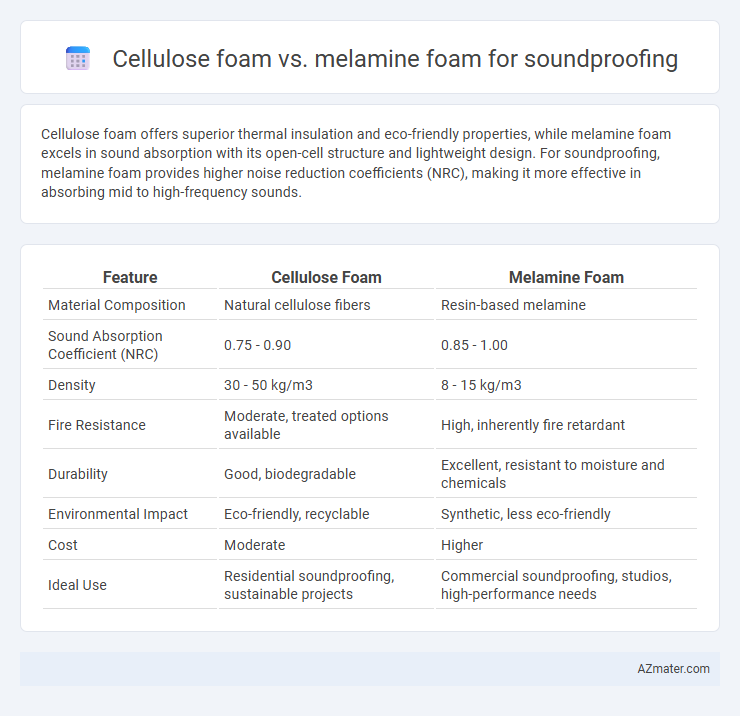Cellulose foam offers superior thermal insulation and eco-friendly properties, while melamine foam excels in sound absorption with its open-cell structure and lightweight design. For soundproofing, melamine foam provides higher noise reduction coefficients (NRC), making it more effective in absorbing mid to high-frequency sounds.
Table of Comparison
| Feature | Cellulose Foam | Melamine Foam |
|---|---|---|
| Material Composition | Natural cellulose fibers | Resin-based melamine |
| Sound Absorption Coefficient (NRC) | 0.75 - 0.90 | 0.85 - 1.00 |
| Density | 30 - 50 kg/m3 | 8 - 15 kg/m3 |
| Fire Resistance | Moderate, treated options available | High, inherently fire retardant |
| Durability | Good, biodegradable | Excellent, resistant to moisture and chemicals |
| Environmental Impact | Eco-friendly, recyclable | Synthetic, less eco-friendly |
| Cost | Moderate | Higher |
| Ideal Use | Residential soundproofing, sustainable projects | Commercial soundproofing, studios, high-performance needs |
Introduction to Acoustic Foam Materials
Cellulose foam and melamine foam are widely used acoustic foam materials designed to absorb sound and reduce noise levels effectively. Cellulose foam, derived from natural fibers, offers excellent environmental benefits while providing good sound absorption and thermal insulation properties. Melamine foam, a synthetic polymer, is known for its superior noise absorption across a broad frequency range, lightweight structure, and fire-resistant characteristics, making it ideal for various soundproofing applications.
What is Cellulose Foam?
Cellulose foam is an eco-friendly soundproofing material made from recycled paper treated with fire retardants to enhance durability and safety. It offers excellent thermal and acoustic insulation properties by trapping sound waves within its porous structure, making it effective in reducing noise transmission. Compared to melamine foam, cellulose foam tends to provide better environmental sustainability and improved sound absorption in low to mid-frequency ranges.
What is Melamine Foam?
Melamine foam is a rigid open-cell foam made from melamine resin, prized for its excellent acoustic absorption and fire-resistant properties, making it effective in soundproofing applications. Unlike cellulose foam, which is derived from recycled paper and primarily used for thermal insulation, melamine foam offers superior sound attenuation by reducing mid to high-frequency noise. Its lightweight structure and resistance to moisture and mold enable long-lasting performance in environments requiring enhanced sound control.
Soundproofing Mechanisms: How Do These Foams Work?
Cellulose foam absorbs sound waves through its porous structure that traps and dissipates acoustic energy, making it effective at reducing mid to high-frequency noise. Melamine foam utilizes an open-cell design with a lightweight, springy matrix that converts sound vibrations into heat, excelling in attenuating a broad range of frequencies including low-frequency sounds. Both foams rely on sound absorption mechanisms but differ in material composition and density, impacting their efficiency and application in soundproofing projects.
Acoustic Performance: Cellulose vs Melamine Foam
Cellulose foam provides effective sound absorption due to its dense, fibrous structure, which traps and dissipates sound waves efficiently, making it suitable for reducing mid to high-frequency noise. Melamine foam excels in acoustic performance with its open-cell, lightweight composition that delivers superior sound absorption across a broad range of frequencies, especially at higher frequencies, while also offering fire resistance and thermal insulation benefits. Choosing between cellulose and melamine foam depends on specific soundproofing needs, frequency range targeting, and additional material properties like fire safety and environmental impact.
Fire Resistance and Safety Comparison
Cellulose foam offers superior fire resistance due to its treatment with fire-retardant chemicals, making it less likely to ignite and emit toxic fumes compared to melamine foam. Melamine foam, while lightweight and effective for sound absorption, tends to have lower fire resistance and can release hazardous gases when exposed to high temperatures. Safety standards often favor cellulose foam in applications requiring enhanced fire protection, highlighting its advantage in reducing fire risk in soundproofing projects.
Durability and Lifespan Differences
Cellulose foam offers superior durability with resistance to compression and moisture, making it ideal for long-term soundproofing projects. Melamine foam, while lightweight and effective for sound absorption, tends to degrade faster under mechanical stress and exposure to environmental factors. The lifespan of cellulose foam generally exceeds melamine foam, maintaining acoustic performance for several decades versus melamine's shorter service life of approximately 5 to 10 years.
Environmental Impact and Sustainability
Cellulose foam, derived from recycled paper products, offers a highly sustainable option for soundproofing due to its biodegradability and low environmental footprint in production compared to synthetic alternatives. Melamine foam, while effective for acoustic applications, is a petroleum-based product with limited recyclability and higher environmental impact during manufacturing and disposal. Choosing cellulose foam supports eco-friendly construction practices by reducing reliance on fossil fuels and promoting use of renewable materials in soundproofing solutions.
Cost Analysis: Cellulose Foam vs Melamine Foam
Cellulose foam offers a cost-effective solution for soundproofing with lower material and installation expenses compared to melamine foam, making it suitable for budget-conscious projects. Melamine foam, while more expensive due to advanced acoustic properties and fire resistance, provides superior noise absorption and durability in professional settings. Evaluating project requirements against budget constraints helps determine the most economical choice between cellulose and melamine foams for soundproofing applications.
Best Applications and Use Cases for Each Foam
Cellulose foam excels in soundproofing applications requiring eco-friendly, breathable insulation, ideal for walls, ceilings, and floors in residential and commercial buildings where moisture control is critical. Melamine foam is best suited for acoustic panels and sound absorption in studios, theaters, and offices due to its lightweight, fire-resistant, and sound-dampening properties. Both foams provide effective noise reduction but cellulose foam is preferable for thermal insulation combined with soundproofing, while melamine foam offers superior absorption for high-frequency noise.

Infographic: Cellulose foam vs Melamine foam for Soundproofing
 azmater.com
azmater.com